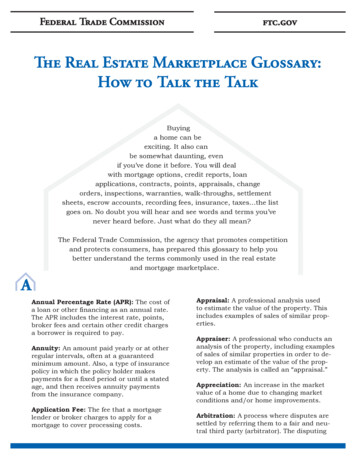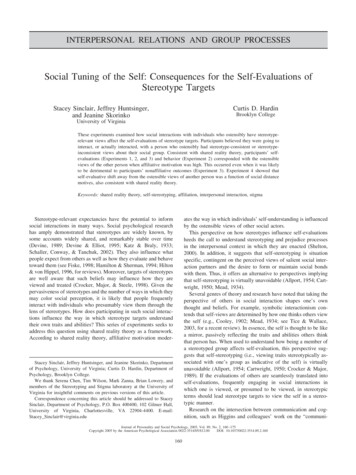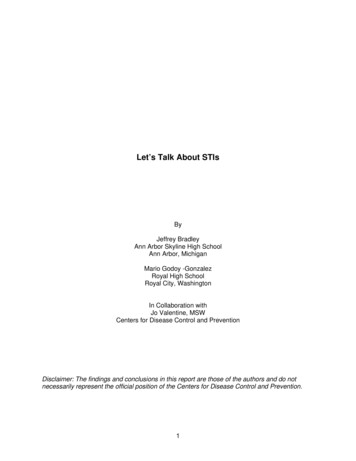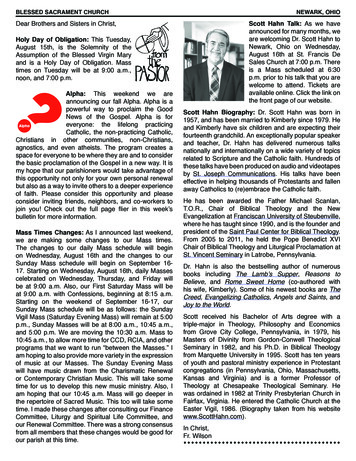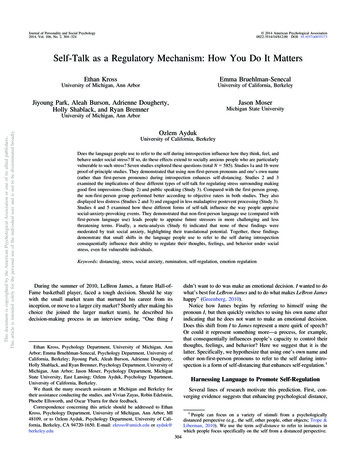
Transcription
Journal of Personality and Social Psychology2014, Vol. 106, No. 2, 304 –324 2014 American Psychological Association0022-3514/14/ 12.00 DOI: 10.1037/a0035173Self-Talk as a Regulatory Mechanism: How You Do It MattersEthan KrossEmma Bruehlman-SenecalUniversity of Michigan, Ann ArborUniversity of California, BerkeleyJiyoung Park, Aleah Burson, Adrienne Dougherty,Holly Shablack, and Ryan BremnerMichigan State UniversityJason MoserThis document is copyrighted by the American Psychological Association or one of its allied publishers.This article is intended solely for the personal use of the individual user and is not to be disseminated broadly.University of Michigan, Ann ArborOzlem AydukUniversity of California, BerkeleyDoes the language people use to refer to the self during introspection influence how they think, feel, andbehave under social stress? If so, do these effects extend to socially anxious people who are particularlyvulnerable to such stress? Seven studies explored these questions (total N 585). Studies 1a and 1b wereproof-of-principle studies. They demonstrated that using non-first-person pronouns and one’s own name(rather than first-person pronouns) during introspection enhances self-distancing. Studies 2 and 3examined the implications of these different types of self-talk for regulating stress surrounding makinggood first impressions (Study 2) and public speaking (Study 3). Compared with the first-person group,the non-first-person group performed better according to objective raters in both studies. They alsodisplayed less distress (Studies 2 and 3) and engaged in less maladaptive postevent processing (Study 3).Studies 4 and 5 examined how these different forms of self-talk influence the way people appraisesocial-anxiety-provoking events. They demonstrated that non-first-person language use (compared withfirst-person language use) leads people to appraise future stressors in more challenging and lessthreatening terms. Finally, a meta-analysis (Study 6) indicated that none of these findings weremoderated by trait social anxiety, highlighting their translational potential. Together, these findingsdemonstrate that small shifts in the language people use to refer to the self during introspectionconsequentially influence their ability to regulate their thoughts, feelings, and behavior under socialstress, even for vulnerable individuals.Keywords: distancing, stress, social anxiety, rumination, self-regulation, emotion regulationdidn’t want to do was make an emotional decision. I wanted to dowhat’s best for LeBron James and to do what makes LeBron Jameshappy” (Greenberg, 2010).Notice how James begins by referring to himself using thepronoun I, but then quickly switches to using his own name afterindicating that he does not want to make an emotional decision.Does this shift from I to James represent a mere quirk of speech?Or could it represent something more—a process, for example,that consequentially influences people’s capacity to control theirthoughts, feelings, and behavior? Here we suggest that it is thelatter. Specifically, we hypothesize that using one’s own name andother non-first-person pronouns to refer to the self during introspection is a form of self-distancing that enhances self-regulation.1During the summer of 2010, LeBron James, a future Hall-ofFame basketball player, faced a tough decision. Should he staywith the small market team that nurtured his career from itsinception, or move to a larger city market? Shortly after making hischoice (he joined the larger market team), he described hisdecision-making process in an interview noting, “One thing IEthan Kross, Psychology Department, University of Michigan, AnnArbor; Emma Bruehlman-Senecal, Psychology Department, University ofCalifornia, Berkeley; Jiyoung Park, Aleah Burson, Adrienne Dougherty,Holly Shablack, and Ryan Bremner, Psychology Department, University ofMichigan, Ann Arbor; Jason Moser, Psychology Department, MichiganState University, East Lansing; Ozlem Ayduk, Psychology Department,University of California, Berkeley.We thank the many research assistants at Michigan and Berkeley fortheir assistance conducting the studies, and Vivian Zayas, Robin Edelstein,Phoebe Ellsworth, and Oscar Ybarra for their feedback.Correspondence concerning this article should be addressed to EthanKross, Psychology Department, University of Michigan, Ann Arbor, MI48109, or to Ozlem Ayduk, Psychology Department, University of California, Berkeley, CA 94720-1650. E-mail: ekross@umich.edu or ayduk@berkeley.eduHarnessing Language to Promote Self-RegulationSeveral lines of research motivate this prediction. First, converging evidence suggests that enhancing psychological distance,1People can focus on a variety of stimuli from a psychologicallydistanced perspective (e.g., the self, other people, other objects; Trope &Liberman, 2010). We use the term self-distance to refer to instances inwhich people focus specifically on the self from a distanced perspective.304
This document is copyrighted by the American Psychological Association or one of its allied publishers.This article is intended solely for the personal use of the individual user and is not to be disseminated broadly.SELF-TALK, REGULATION, AND SOCIAL ANXIETYwhich we construed broadly as the capacity to transcend one’segocentric viewpoint of a stimulus, facilitates self-regulation. Research in children and adults indicates, for example, that psychological distancing strategies enhance people’s capacity to exertself-control when faced with tempting options in the short term(e.g., Fujita, Trope, Liberman, & Levin-Sagi, 2006; Kober et al.,2010; Mischel & Rodriguez, 1993; Sigel & McGillicuddy-De Lisi,2003). In a similar vein, research on self-reflection indicates thatcueing people to reflect on painful past experiences from a selfdistanced or “fly-on-the-wall” visual perspective helps them reflect on their experiences without ruminating (Gruber, Harvey, &Johnson, 2009; Kross & Ayduk, 2011; also see Ray, Wilhelm, &Gross, 2008; Wisco & Nolen-Hoeksema, 2011).The concept of self-distancing also factors prominently intoseveral cognitive and behavioral treatment paradigms. Beck (1970)described distancing as a process that allows clients to thinkobjectively about irrational thoughts and emphasized the importance of this process for effective cognitive therapy (pp. 189 –190)—a view that many scholars have since echoed (e.g., Fresco,Segal, Buis, & Kennedy, 2007; Ingram & Hollon, 1986). Theconcept of distancing, although sometimes referred to as “decentering” or “self as context,” is also central to many newer forms ofcognitive therapy, which emphasize the importance of enhancingpsychological distance from the self for allowing people to observeand accept their feelings (e.g., Hayes, Luoma, Bond, Masuda, &Lillis, 2006; Teasdale et al., 2002).These findings are noteworthy in the current context becauseresearchers have speculated that the language people use to refer tothe self may influence self-distancing. For example, research onexpressive writing conceptualizes the degree of first-person pronouns that people use when writing about emotional experiencesas a marker of self-distancing—the fewer first-person pronounspeople use, the more people attempt to distance themselves fromtheir experiences (e.g., Cohn, Mehl, & Pennebaker, 2004; also seePennebaker & King, 1999). Supporting this inference, cueingpeople to reflect on emotional (Grossmann & Kross, 2010; Kross& Ayduk, 2008) and nonemotional (Mcisaac & Eich, 2002) experiences from the visual perspective of a psychologically distancedobserver (compared with a first-person visual perspective) leadsthem to describe these experiences using fewer first-person pronouns.Why might certain patterns of language use, in particular people’s use of non-first-person pronouns and their own name to referto the self, promote self-distancing? In general, people use theseparts of speech when thinking about, referencing, or speaking to otherpeople. Thus, if people use these parts of speech to refer to the self,this may enhance self-distancing by leading people to think aboutthemselves as though they were someone else—albeit another selfwhose inner thoughts and feelings they have privileged access to.In contrast, people virtually exclusively use first person pronounswhen thinking about or referring to the self from their egocentricpoint of view. Thus, people who use these parts of speech duringintrospection should think about the self as they normally do—from a self-immersed, first-person perspective.In sum, our analysis suggests that the language people use torefer to the self during introspection may influence self-distancing,and thus have consequential implications for their ability to regulate their thoughts, feelings, and behavior under stress. Our firstgoal was to explore this question.305Exploring Generalizability to Vulnerable Populations:Social AnxietyOur second goal was to explore whether social anxiety moderates the self-regulatory benefits of non-first-person language useduring introspection. We focused on social anxiety because it canbe studied in the laboratory with a high degree of ecologicalvalidity. That is, the situations that socially anxious people fearmost— being evaluated by others in a social context— can besimulated in the laboratory relatively easily, in ways that lendthemselves well to testing predictions about mechanisms underlying self-regulation. Moreover, social anxiety is one of the mostcommon forms of anxiety (e.g., Kessler, Berglund, Demler, Jin, &Walters, 2005). From the apprehensive partygoer to the anxiouspublic speaker to the socially phobic patient, countless peopleexperience social anxiety and the concomitant negative psychological and physical consequences that it generates.Cognitive models of social anxiety suggest that socially anxiousindividuals experience high levels of anxiety in response to thethreat of future social interactions (D. M. Clark & Wells, 1995;Rapee & Heimberg, 1997). When these situations are possible,they worry excessively about the likelihood of performing poorly,which interferes with their performance. The perception and actuality of their poor performance reinforce their negative beliefsabout the self, giving rise to maladaptive postevent processing orrumination (Brozovich & Heimberg, 2008).In current cognitive behavioral therapies, social anxiety istreated by challenging negative expectations about upcomingevents (e.g., D. M. Clark et al., 2003). However, to the extent thatthe language people use to refer to the self during introspectioninfluences self-regulation, it might provide an additional (potentially easily implemented) tool for helping vulnerable populationscope with social threat.Research OverviewSeven studies examined whether language use during introspection influences people’s ability to self-regulate under social stress.Studies 1a and 1b were proof-of-principle studies. They examinedwhether using non-first-person pronouns and one’s own name(non-first-person group from hereon) rather than first-person pronouns (first-person group from hereon) during introspection enhances self-distancing. Studies 2 and 3 then examined the implications of these different forms of self-talk for regulating thecognitive, emotional, and behavioral sequalae of social stress.Studies 4 and 5 examined how these different forms of self-talkinfluence the way people appraise future stressors. Finally, Study6 consisted of a meta-analysis that combined data from Studies 2through 5 to examine whether trait social anxiety moderates theself-regulatory effects of non-first-person language use.Studies 1a and 1bOur starting point is that using non-first-person pronouns andone’s own name to refer to the self during introspection promotesself-distancing. One way to test this prediction is to examinewhether language use during self-reflection influences the vantagepoint that people adopt when visualizing emotional experiences. Ifnon-first-person language use (i.e., “linguistic” self-distancing)
KROSS ET AL.This document is copyrighted by the American Psychological Association or one of its allied publishers.This article is intended solely for the personal use of the individual user and is not to be disseminated broadly.306enhances self-distancing, then people who use this type of language during introspection should be more likely to report seeingthemselves in their past experience from an observer’s visualperspective (i.e., “visual” self-distancing) than people who usefirst-person pronouns during introspection. This logic is broadlyconsistent with construal level theory, which suggests that potentiating psychological distance in one domain enhances psychological distance in other domains (Trope & Liberman, 2003, 2010).We tested this prediction by asking participants to analyze theirfeelings surrounding an anger-provoking (Study 1a) and anxietyprovoking (Study 1b) negative autobiographical experience usingfirst-person pronouns or non-first-person pronouns and their ownname. We focused on two types of negative emotional experiencesin these studies to examine the reliability and generalizability ofour findings. After participants analyzed their feelings, we askedthem to indicate the degree to which they adopted the visualperspective of an observer as they reflected on their feelings.(Study 1a: n 28; Study 1b: n 44). The instructions used tomanipulate linguistic self-distancing were identical in both studies.Participants in the first person group were told:One of the things we’re interested in in this study is the languagepeople use to understand their feelings. Some people try to understandtheir feelings by thinking about themselves using first-person pronouns, so this is what we would like you to do. Please try tounderstand why you felt the way you did in the experience you justrecalled using the pronouns “I” and “my” as much as possible. Inother words, ask yourself, “Why did I feel this way? What were theunderlying causes and reasons for my feelings?”Participants in the non-first-person group were told:One of the things we’re interested in in this study is the languagepeople use to understand their feelings. Some people try to understandtheir feelings by thinking about themselves using their own name andother non-first-person pronouns, so this is what we would like you todo. Please try to understand why you felt the way you did in theexperience you just recalled using the pronoun “you” and “[your ownname]” as much as possible. In other words, if your name was Jane,you would ask yourself, “Why did Jane feel this way? What were theunderlying causes and reasons for Jane’s feelings?”2MethodParticipants. In Study 1a, participants were 56 undergraduates (Mage 18.95 years, SDage 4.74; 38 females; 52% White,23% Asian American, 11% African American, and 14% other)who received course credit for their participation. In Study 1b, 93participants were recruited through Amazon Mechanical Turk(MTurk; Mage 32.23 years, SDage 12.98; 50 females; 79.6%White, 12.9% Asian American, 2.2% African American, and 5.5%other).Procedure and materials.Baseline affect. After providing informed consent, participants in both studies rated how they felt “right now” (1 verynegative, 9 very positive; Study 1a: M 6.35, SD 1.17; Study1b: M 6.74, SD 1.46).Negative experience recall task. Next, we asked participantsto recall for Study 1a an anger-related autobiographical experience:No matter how well two people get along there are times when theyexperience conflict . . . [T]ake a few moments right now to recall atime when you experienced such conflict with another person—a timewhen you became truly enraged at this person.For Study 1b, we asked participants to recall an anxiety-relatedautobiographical experience:No matter how satisfied people are with their lives, there are timeswhen they worry and experience anxiety . . . [T]ake a few momentsright now to think about a time from your past when you worriedabout something happening to you.They were given as much time as they needed to recall theirexperience (Study 1a: Msec 37.18, SDsec 19.36; Study 1b:Msec 45.16, SDsec 24.72). Aside from cueing people to recalldifferent types of experiences, the only other difference betweenthe two sets of recall instructions was that in Study 1b, weinstructed participants to “close their eyes” before the memoryrecall instructions, whereas participants in Study 1a did not receivethis instruction.Experimental manipulation. Participants were then randomlyassigned to reflect on their feelings surrounding their recalledexperience using first-person pronouns (Study 1a: n 28; Study1b: n 49) or non-first-person pronouns and their own nameParticipants had 60 s to reflect on their feelings following theseinstructions.Visual self-distance. Following prior research (Mischowski,Kross, & Bushman, 2012; Park et al., 2013), participants completed two items to measure visual self-distancing after the reflection period was over. First, participants rated the extent to whichthey saw the event replay through their own eyes versus watchedthe event unfold as an observer as they analyzed their feelings (1 predominantly immersed participant, 7 predominantly distanced observer). Second, they rated how far away from the scenethey were as they analyzed their feelings (1 very close, saw itthrough my own eyes; 7 very far, saw it as if an observer).Ratings on these items were averaged to create a visual selfdistancing index, Study 1a: .74, M 2.72, SD 1.40; Study1b: .85, M 3.13, SD 1.66.Instructional manipulation check. Because we had less control over the online environment in which Study 1b was performed,we administered an instructional manipulation check at the end ofthe study to ensure that participants paid attention to our instructions. Specifically, participants read, “We are interested in whether youactually take the time to read the directions . . . [I]n order todemonstrate that you have read these instructions, please select‘online shopping’ and ‘check e-mail only’ below.” Participantswere then presented with a series of Internet activity choices with“online shopping” and “check e-mail only” embedded amongthem.Results and DiscussionPreliminary analyses. Twenty-one participants failed the instructional manipulation check: 14 in the first person group and seven inthe non-first-person group. They were excluded from subsequentanalyses on a priori grounds, leaving 72 participants in Study 1b,35 in the first person group, and 37 in the non-first-person group.2Jane was replaced with Joe for male participants.
This document is copyrighted by the American Psychological Association or one of its allied publishers.This article is intended solely for the personal use of the individual user and is not to be disseminated broadly.SELF-TALK, REGULATION, AND SOCIAL ANXIETYThis exclusion rate (23%) is consistent with prior studies that haveused instructional manipulation checks (Oppenheimer, Meyvis, &Davidenko, 2009). Exclusions did not differ by condition, Study1a: 2(1) 0.06, p .80; Study 1b: 2(1) 2.13, p .15.All analyses controlled for baseline affect, which the groups didnot differ on, Fs 1. Gender was not related to the dependentvariable in either study, Fs 1, and controlling for it did notsubstantively alter any of the results. Three participants (one inStudy 1a; two in Study 1b) had missing values because of omittedresponses.Visual self-distancing. As expected, participants in the nonfirst-person groups displayed significantly higher levels of visualself-distancing than participants in the first-person groups in bothStudy 1a, F(1, 52) 5.96, p .018, p2 .103, and Study 1b, F(1,67) 4.45, p .039, p2 .062 (see Figure 1). These findingsdemonstrate that using non-first-person pronouns and one’s ownname to refer to the self enhances self-distancing.Studies 2 and 3: OverviewHaving established that using non-first-person language to referto the self during introspection increases self-distancing, we examined in Studies 2 and 3 whether language use during introspection influences self-regulation under social stress. Both Studies 2and 3 focused on these same core issues but were designed bydifferent laboratories and implemented independently. As a result,they had similar procedures and focused on a partially overlappingset of dependent variables. Thus, they provide convergent evidence for the role that language use plays in self-regulation acrossdifferent situations, laboratories, and measures.3Study 2We recruited participants for a study on the psychology of firstimpressions. They were told that they would be asked to make apositive first impression on another person. Prior to engaging inthis task, we asked them to reflect on their feelings concerningtheir upcoming social interaction using either first-person pro-Figure 1. The effect of condition on visual self-distancing in Study 1aand Study 1b measured on scales ranging from 1 (predominantly immersedparticipant) to 7 (predominantly distanced observer). Error bars indicatestandard errors.307nouns or non-first-person pronouns and their own name. We thenexamined the effect of this manipulation on participants’ anxietyand performance during the social interaction. We predicted thatparticipants in the non-first-person group would experience lessanxiety and perform better during the impression formation task.MethodParticipants. Participants were 97 undergraduate women(Mage 20.05 years, SDage 1.86; 26.8% White, 49.5% AsianAmerican, 5.1% African American, and 18.6% other) who received course credit or payment for participating. We focused onwomen only in this study because they are disproportionatelyaffected by anxiety-related problems, including social anxiety(Kessler et al., 1994; Spurr & Stopa, 2002; Weinstock, 1999).Procedure and materials.Phase 1: Trait social anxiety. Participants completed the 12item Brief Fear of Negative Evaluation Scale (BFNE; Leary, 1983)online approximately 5 days (M 5.19 days, SD 3.41) beforethe study. Sample items include, “I am afraid that others will notapprove of me” and “Sometimes I think I am too concerned withwhat other people think of me” (1 not at all characteristic of me,5 extremely characteristic of me; .80; M 37.03, SD 9.23).Phase 2: Cover story and premanipulation anxiety. Informedconsent was obtained at the beginning of the experiment. As partof this process, we informed participants that they would be havinga videotaped conversation with another participant. Next, participants rated how anxious they felt (1 not at all, 5 extremely;M 2.30, SD 0.96).Phase 3: Explanation of study. An experimenter told participants that the study focused on impression formation. Specifically, they were told that their goal would be to make a good firstimpression during a short conversation with an opposite sex participant after which they would be evaluating each other’s performance. In addition, they were informed that their conversationwould be videotaped and assessed by trained psychologists whowould be rating their social skills. Such “getting to know you”tasks are commonly used to elicit social anxiety in the laboratory(e.g., J. V. Clark & Arkowitz, 1975; Glass, Merluzzi, Biever, &Larsen, 1982; Turner, Beidel, & Larkin, 1986).Next, the experimenter added that an additional goal of the studywas to examine how people can effectively prepare themselves tomake good first impressions. Thus, they were told that they wouldbe receiving instructions about how to prepare themselves for theirsocial interaction in a few moments. After these instructions wereconveyed, the experimenter left the participant alone in a roomwithout any distractions for 2 min. During this time, the experimenter retrieved the participant’s condition assignment from another room.Phase 4: Experimental manipulation. After the 2-min waiting period, the experimenter told participants, “We are interestedin the different ways people go about preparing themselves psychologically for meeting new people and what effect each type ofself-preparation has on performance.” They were then randomly3In Studies 2 and 3, a number of additional measures were included forexploratory purposes. They are available upon request from the corresponding authors.
This document is copyrighted by the American Psychological Association or one of its allied publishers.This article is intended solely for the personal use of the individual user and is not to be disseminated broadly.308KROSS ET AL.assigned to a first-person (n 48) or non-first-person (n 49)condition using instructions that were virtually identical to thoseused in Study 1. The main difference was that participants wereasked to think about their feelings concerning an upcominganxiety-provoking event (rather than a past experience). Followingthese instructions, participants reflected over their thoughts andfeelings alone for 3 min.Phase 5: Manipulation check and preinteraction anxiety.Following the experimental manipulation, participants answeredthe following questions, “How well do you feel you followed thespeech preparation instructions” (1 not at all well, 5 perfectlywell) and “To what extent did you use the first-person pronouns Iand me (or non-first-person pronouns you and your own name) torefer to yourself when you were working through your thoughtsand feelings about the upcoming conversation (1 not at all, 5 exclusively). Scores on these questions were averaged to create amanipulation check index ( .68; M 3.79, SD 0.70). Next,participants rated their anxiety again, using the same question thatwas administered prior to the manipulation (M 2.84, SD 0.97).Phase 6: Social evaluation task. Subsequently, the experimenter introduced the participant to a new experimenter and theirinteraction partner, who was in fact a confederate. Prior researchindicates that opposite sex interactions are more anxiety provokingthan same sex interactions, especially for socially anxious people(e.g., Turner et al., 1986). Therefore, following prior research (e.g.,Burgio, Merluzzi, & Pryor, 1986; J. Clark & Arkowitz, 1975;Glass et al., 1982; Kashdan & Roberts, 2006), the confederate inthis study was always male. Both the new experimenter andconfederate were blind to condition.Unstructured interaction. The interaction began when the newexperimenter and confederate entered the room and sat across fromthe participant. The experimenter told the participant that he or shehad to leave the room to calibrate the cameras and would returnshortly. The participant was given no instructions about how tointeract with the confederate during this period. We included thisunstructured interaction period to explore whether the manipulation influenced participants’ tendencies to spontaneously initiateconversation with their partner. Confederates were instructed notto initiate conversation for the first 30 s. After an initial silence of30 s, the confederate initiated contact by saying, “It wasn’t easy tofind the room here today.” Three condition-blind raters codedwhether participants initiated conversation during the first 30 s(intraclass correlation [ICC] 1).Structured interaction. When the experimenter returned, he orshe presented the participant and the confederate with instructionsfor the social interaction. Following the procedure used by Meleshko and Alden (1993), participants were given a list of topics totalk about (e.g., “What have you always wanted to try buthaven’t?”; “What is your biggest pet peeve?”). The experimenterinstructed them to take turns selecting and answering questionsfrom this list until they had both answered four questions. Theconfederate always began the exchange and disclosed on the samefour questions with all participants. Confederates’ responses werescripted so that the content and delivery of their disclosures wasconsistent. The experimenter left the room prior to the initiation ofthe conversation and returned after the conversation was over.Three judges rated participants’ performance during this phaseon two dimensions. First, they rated how nervous the participantwas (1 below average level of nervousness, 5 above averagelevel of nervousness; ICC .73; M 2.87, SD 0.78). Second,they rated participants’ overall performance using a modifiedversion of the Social Performance Rating Scale (Fydrich, Chambless, Perry, Buergener, & Beazley, 1998)—a behavioral assessment of social performance designed for social phobia. Specifically, judges coded participants’ behavior along the following fourdimensions using a 5-point scale (1 poor, 5 excellent): gaze,vocal quality, speech length, and discomfort (ICC .73).4 Gazerefers to whether the participant made appropriate eye contact withthe confederate. Vocal quality refers to whether the participantspoke clearly and varied her vocal tone in an engaging manner.Length refers to whether the participant spoke for an appropriateamount of time when answering the questions (i.e., neither beingoverly brief nor long-winded) and lacked awkward pauses. Discomfort refers to whether the participant showed verbal (e.g.,speech dysfluencies) and nonverbal (e.g., self-manipulative behaviors like hair twirling, facial touching, and so on) indicators ofanxiety during the interaction. Following Fydrich et al. (1998), wecreated a measure of overall performance by summing participants’ scores on these dimensions ( .80; M 13.10, SD 2.05).Preliminary analyses indicated that scores on the nervousnessand overall performance indexes were highly correlated. Therefore, we collapsed them to create a composite behavioral index ofsocial interaction performance after reverse scoring the nervousness scale and then standardizing scores on each measure ( .84).Phase 7: Postinteraction anxiety. Participants rated their anxiety at the en
experience social anxiety and the concomitant negative psycho-logical and physical consequences that it generates. Cognitive models of social anxiety suggest that socially anxious individuals experience high levels of anxiety in response to the threat of future social interactions (D.
